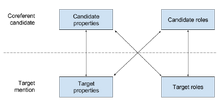(david bean) Tags: Visual edit apiedit |
(Ng (2010)) Tags: Visual edit apiedit |
||
| (One intermediate revision by the same user not shown) | |||
| Line 1: | Line 1: | ||
| + | [[File:Role-and-coreference.png|thumb|220x220px|Figure 1: Types of information related to semantic roles that can be used by a coreference resolver]] |
||
| + | From Ng (2010)<ref>Ng, V. (2010). Supervised Noun Phrase Coreference Research: The First Fifteen Years. ''Acl'', (July), 1396–1411. http://doi.org/10.1109/TVCG.2007.24</ref>: "One of the earliest kinds of semantic knowledge employed for coreference resolution is perhaps selectional preference (Dagan and Itai, 1990; Kehler et al., 2004b; Yang et al., 2005; Haghighi and Klein, 2009): given a pronoun to be resolved, its governing verb, and its grammatical role, we prefer a candidate antecedent that can be governed by the same verb and be in the same role. |
||
| + | |||
| + | [...] |
||
| + | |||
| + | Contextual roles (Bean and Riloff, 2004), semantic relations (Ji et al., 2005), semantic roles (Ponzetto and Strube, 2006b; Kong et al., 2009), and animacy (Or˘asan and Evans, 2007) have also been exploited to improve coreference resolution." |
||
TODO: Ponzetto and Strube (2006)<ref>Ponzetto, Simone Paolo, and Michael Strube. "Exploiting semantic role labeling, WordNet and Wikipedia for coreference resolution." ''Proceedings of the main conference on Human Language Technology Conference of the North American Chapter of the Association of Computational Linguistics''. Association for Computational Linguistics, 2006.</ref>: |
TODO: Ponzetto and Strube (2006)<ref>Ponzetto, Simone Paolo, and Michael Strube. "Exploiting semantic role labeling, WordNet and Wikipedia for coreference resolution." ''Proceedings of the main conference on Human Language Technology Conference of the North American Chapter of the Association of Computational Linguistics''. Association for Computational Linguistics, 2006.</ref>: |
||
== David Bean's contextual role knowledge (BABAR) == |
== David Bean's contextual role knowledge (BABAR) == |
||
| + | David Bean proposed a ... model (...) that makes use of events (in MUC formalism) to support coreference solution. All types of information in Figure 1 was used. |
||
| − | David Bean proposed a mention-pair model<ref>In Bean and Riloff (2004): "For each candidate antecedent, BABAR identifies the caseframe that would extract the candidate, pairs it with the anaphor’s caseframe, and consults the CF Network to see if this pair of caseframes has co-occurred in previous resolutions. If so, the CF Network reports that the anaphor and candidate may be coreferent."</ref> that makes use of events (in MUC formalism) to support coreference solution. |
||
| + | * role-role: co-occurring events are stored and used to support prediction, e.g. murder of <NP> is followed by <agent> damaged, killed <patient> is followed by was injured in <NP> (see Figure 1 in Bean and Riloff (2004)<ref name=":0">Bean, D., & Riloff, E. (2004). Unsupervised Learning of Contextual Role Knowledge for Coreference Resolution. ''Proceedings of the Human Language Technology Conference of the North American Chapter of the Association for Computational Linguistics (HLT-NAACL 2004)'', 297–304.</ref>) |
||
| + | * mention-role: "(1) whether the anaphor is among the lexical expectations for the caseframe that extracts the candidate antecedent, and (2) whether the candidate is among the lexical expectations for the caseframe that extracts the anaphor. If either case is true, then CFLex reports that the anaphor and candidate might be coreferent." (Bean and Riloff, 2004)<ref name=":0" /> |
||
| + | <nowiki> </nowiki>TODO: "A knowledge source may return a positive value (0.0 to 1.0), indicating supportive evidence, or it may return a negative value (-1.0 to 0.0), indicating contradictory evidence." |
||
== References == |
== References == |
||
Latest revision as of 12:29, 2 May 2017

Figure 1: Types of information related to semantic roles that can be used by a coreference resolver
From Ng (2010)[1]: "One of the earliest kinds of semantic knowledge employed for coreference resolution is perhaps selectional preference (Dagan and Itai, 1990; Kehler et al., 2004b; Yang et al., 2005; Haghighi and Klein, 2009): given a pronoun to be resolved, its governing verb, and its grammatical role, we prefer a candidate antecedent that can be governed by the same verb and be in the same role.
[...]
Contextual roles (Bean and Riloff, 2004), semantic relations (Ji et al., 2005), semantic roles (Ponzetto and Strube, 2006b; Kong et al., 2009), and animacy (Or˘asan and Evans, 2007) have also been exploited to improve coreference resolution."
TODO: Ponzetto and Strube (2006)[2]:
David Bean's contextual role knowledge (BABAR)[]
David Bean proposed a ... model (...) that makes use of events (in MUC formalism) to support coreference solution. All types of information in Figure 1 was used.
- role-role: co-occurring events are stored and used to support prediction, e.g. murder of <NP> is followed by <agent> damaged, killed <patient> is followed by was injured in <NP> (see Figure 1 in Bean and Riloff (2004)[3])
- mention-role: "(1) whether the anaphor is among the lexical expectations for the caseframe that extracts the candidate antecedent, and (2) whether the candidate is among the lexical expectations for the caseframe that extracts the anaphor. If either case is true, then CFLex reports that the anaphor and candidate might be coreferent." (Bean and Riloff, 2004)[3]
TODO: "A knowledge source may return a positive value (0.0 to 1.0), indicating supportive evidence, or it may return a negative value (-1.0 to 0.0), indicating contradictory evidence."
References[]
- ↑ Ng, V. (2010). Supervised Noun Phrase Coreference Research: The First Fifteen Years. Acl, (July), 1396–1411. http://doi.org/10.1109/TVCG.2007.24
- ↑ Ponzetto, Simone Paolo, and Michael Strube. "Exploiting semantic role labeling, WordNet and Wikipedia for coreference resolution." Proceedings of the main conference on Human Language Technology Conference of the North American Chapter of the Association of Computational Linguistics. Association for Computational Linguistics, 2006.
- ↑ 3.0 3.1 Bean, D., & Riloff, E. (2004). Unsupervised Learning of Contextual Role Knowledge for Coreference Resolution. Proceedings of the Human Language Technology Conference of the North American Chapter of the Association for Computational Linguistics (HLT-NAACL 2004), 297–304.